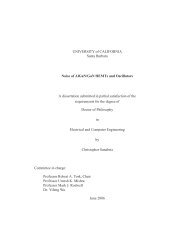Sine Wave Generation Techniques
Sine Wave Generation Techniques
Sine Wave Generation Techniques
You also want an ePaper? Increase the reach of your titles
YUMPU automatically turns print PDFs into web optimized ePapers that Google loves.
SINE APPROXIMATION�DIGITAL METHODS<br />
Digital methods may be used to approximate sine wave operation<br />
and offer the greatest flexibility at some increase in<br />
complexity� Figure 12 shows a 10-bit IC D�A converter driven<br />
from up�down counters to produce an amplitude-stable<br />
triangle current into the LF357 FET amplifier� The LF357 is<br />
used to drive a shaper circuit of the type shown in Figure 10�<br />
The output amplitude of the sine wave is stable and the<br />
frequency is solely dependent on the clock used to drive the<br />
counters� If the clock is crystal controlled� the output sine<br />
wave will reflect the high frequency stability of the crystal� In<br />
this example� 10 binary bits are used to drive the DAC so<br />
the output frequency will be 1�1024 of the clock frequency�<br />
If a sine coded read-only-memory is placed between the<br />
counter outputs and the DAC� the sine shaper may be elimi-<br />
TL�H�7483–17<br />
nated and the sine wave output taken directly from the<br />
LF357� This constitutes an extremely powerful digital technique<br />
for generating sine waves� The amplitude may be voltage<br />
controlled by driving the reference terminal of the DAC�<br />
The frequency is again established by the clock speed used<br />
and both may be varied at high rates of speed without introducing<br />
significant lag or distortion� Distortion is low and is<br />
related to the number of bits of resolution used� At the 8-bit<br />
level only 0�5% distortion is seen (waveforms� Figure 13�<br />
graph� Figure 14) and filtering will drop this below 0�1%� In<br />
the photo of Figure 13 the ROM directed steps are clearly<br />
visible in the sine waveform and the DAC levels and glitching<br />
show up in the distortion analyzer output� Filtering at the<br />
output amplifier does an effective job of reducing distortion<br />
by taking out these high frequency components�<br />
Trace Vertical Horizontal<br />
A 20V�DIV<br />
B 20V�DIV 20 ms�DIV<br />
C 10V�DIV<br />
D 10V�DIV<br />
E 0�5V�DIV<br />
FIGURE 11� Logarithmic shapers can utilize a variety of circuit waveforms� The input to the LF356 integrator (Figure 10)<br />
appears here as trace A� The LM311’s input (trace B) is the summed result of the integrator’s triangle output (C) and the<br />
LM329’s clamped waveform� After passing through the 2N3810�LM394 shaper stage� the resulting sine wave is<br />
amplified by the LF351 (D)� A distortion analyzer’s output (E) represents a 0�35% total harmonic distortion�<br />
10









